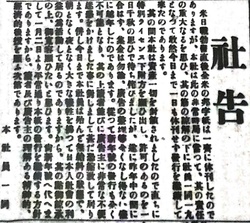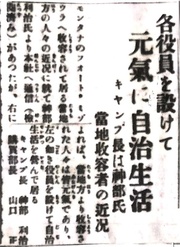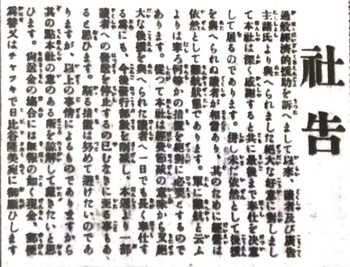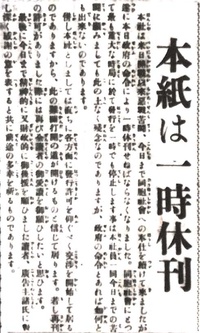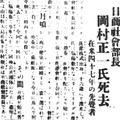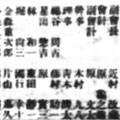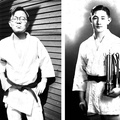In the last part, I talked about Sumiyoshi Arima’s articles in The North American Times written as Chairperson of the Japanese Association and a newspaper reporter. In this part, I would like to introduce some articles that were published at the beginning of World War II and the last issue of The North American Times.
BEGINNING OF WORLD WAR II
The attack on Pearl Harbor on December 7, 1941 shook the Japanese community in Seattle. By that time, Sumio Arima, Sumiyoshi’s younger brother, had taken over the Managing Editor role after Sumiyoshi left Seattle. On the day of the Pearl Harbor attack, the FBI came to Sumio’s home and arrested him. The company’s funds were frozen. Under such circumstances, the remaining staff members, including editors Takami Hibiya and Terumitsu Kano, continued publishing the paper. In fact, The North American Times was the only Japanese newspaper in the United States that published on December 8, the day after the Pearl Harbor attack.
Ito Kazuo’s Hokubei hyakunen zakura explains why The North American Times was able to publish the day after Pearl Harbor. There it says, “Mr. Takami Hibiya, who became the Deputy Editor of The North American Times, asked Nisei Jimmy Sakamoto of the Japanese American Courier (a weekly English newspaper) for his help. Hibiya then received approval from the Chief Prosecutor of the State of Washington.”
EMPLOYEES’ EFFORTS TO CONTINUE THE PAPER
An editorial note entitled “Company Announcement,” was published the day after New Year’s, just after the war between Japan and the United States began. It is an article that conveys the situation and thoughts of the employees who were continuing to publish during the emergency.
“Company Announcement” (From Jan. 2, 1942 issue)
“Immediately after the outbreak of the war between the United States and Japan, Japanese newspapers in the United States were all suspended at once. However, as we take our responsibilities seriously during this emergency, all the employees of the head office are working hard to continue publishing our daily issues.
“Meanwhile, the headquarters was cut off from all assets. We immediately applied for a special license and waited for permission. However, we still have not received any approval. We have no access to our funds. We are not able to work on invoicing for receivables. We are not able to organize advertisements. We passed New Year’s Day in this difficult situation. We regret that we were not able to publish our New Year’s issue and are sorry to all the advertisers and subscribers.
“However, we would like to ask for your generous understanding in that all employees are working day and night without receiving any salary. We work hard sacrificing ourselves to serve the Japanese community. We will resume publishing regularly starting with this January 2nd issue. We will appreciate subscribers’ and advertisers’ financial and moral support. — From all head office employees.”
“Doing Well Under Autonomy" (From Jan. 30, 1942 issue)
There is an article about men who were taken to the Fort Missoula detention camp in Montana immediately after the start of the war. The article reported that people at the camp were doing well, by governing themselves. According to the article, Tadashi Yamaguchi, who had previously worked at the Tacoma office of the North American Times, was working as a Purchasing Manager for the camp.
INCARCERATION AND END OF THE NORTH AMERICAN TIMES
On February 19, President Franklin Roosevelt issued Executive Order 9066, which made the incarceration of Issei Japanese and Nisei Japanese Americans a reality. Still, the employees continued publishing the daily paper, by continually asking for financial support. It seemed like some people cared and provided support.
An editorial note on February 24 says, “Thank you so much for the support from patients in a sanatorium.”
Another note on February 25 says, “Someone donated a box of oranges for our employees.”
Here is a note I found in the issues of March 6 – 11: “In order to reduce costs so we can continue as long as possible, we have to reduce the circulation and stop shipping to some readers. Please send your financial support to Takami Hibiya.”
On March 12, 1942, the publication of North American Times finally came to an end. It was about a month before April 21, when the Japanese in Seattle would be forced to leave. An English article was posted on the first page of the last issue.
“This is the Last Issue” (From Mar. 12, 1942 issue)
“Beginning tomorrow, THE NORTH AMERICAN TIMES will be no more. Just how long, we do not know.
“But the final decision was reached when the United States Treasury Department this morning notified us that the TIMES must cease publication.
“It must be disheartening news to all of our thousands of readers throughout the Northwest who have always looked forward to each copy of the TIMES for its accurate account of activities among resident Japanese.
“And it is also disheartening to us in that we — and much as we hated to see this come to a head — must suspend publication, especially in view of the fact that the TIMES, established in 1903, was the oldest Japanese language and English section family newspaper in the Northwest.
“And we are more so disappointed because we are no longer able to serve the Japanese public as a medium of releasing valuable information for the United States Department of Justice, War Department and other government agencies.
“Yes, regretfully disappointed because we felt that it was vitally necessary to have the TIMES continue, at least until the evacuation of the Japanese, so that resident Japanese of American ideals and democracy may be kept intact so as to comply sanely with army and government officials.
“With this edition, the TIMES says ‘30’*1 and with a ‘30’ ending, the editors honestly hope the Japanese readers of this newspaper will not lose confidence in the United States and continue to support the cause for which the United States is fighting. —bf”
The letters bf at the end of the English text suggests that English editor Budd Fukui wrote this article.
On the third page of the same issue was a message in Japanese titled “We will suspend publication temporarily.”
“Since the outbreak of the U.S.-Japan war, we have been struggling and trying our best to serve our community; but today, due to the government order, we have come to face no choice but to suspend publication temporarily. Considering the struggle we have faced so far, it is our deepest regret to stop publication even for a temporary period in this most critical time for our fellow community, but there is nothing we can do when the government sends its order.
“We would like to tell you, however, that we have immediately started talking with some people in different fields to get permission to publish again, and we believe that we will find a way to overcome this challenge. When we do get the permission, we will surely be reaching out to all our readers for their support again. On a final note, we would like to express our deepest gratitude to our readers and sponsors who have supported us all this time mentally as well as financially, and we wish you all the best and happiness in your future.”
The last issue of The North American Times was number 12,278. The newspaper, which had served Seattle’s Japanese community for nearly 40 years, had come to its end in history. I admire the employees who continued to publish it with a strong sense of responsibility, which I believe continued during the paper’s long history.
After the war, Mr. Hibiya and Mr. Kano would reestablish the paper as The North American Post.
In the next chapter, I will introduce articles about picture brides, which published from 1918 to the 1920’s.
*Editor's note: -30- has been traditionally used by journalists in North America to indicate the end of a story or article that is submitted for editing and typesetting. (Wikipedia.com) Fukui used “30” to indicate the last issue of The North American Times.
Reference:
Kazuo Ito, Zoku hokubei hyakunen zakura (Sequel of 100-Year Cherry Blossoms in North America), Nichibou Shuppan, 1971.
Kazuo Ito, America shunju hachijyu nen (America Spring and Autumn 80-Year), PMC Publishing, 1982.
The North American Post, “100th Anniversary Special Issue,” North American Post Publishing, 2002.
Sumisato Arima, Shiatoru nikkan hojishi no 100-nen (100 Years of Daily Japanese Newspapers in Seattle), Tsukiji Shokan, 2005.
*The English version of this series is a collaboration between Discover Nikkei and The North American Post, Seattle’s bilingual community newspaper. This article was originally publishd on February 12, 2022 in The North American Post and is modified for Discover Nikkei.
© 2022 Ikuo Shinmasu


